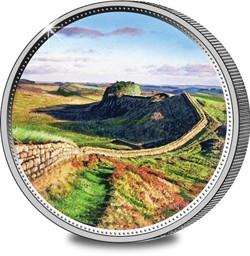-no-button.jpg)
 |
Location: Running from Wallsend Northumberland to
Solway Firth, Cumberland
Date completed: c. 122 AD
Designers/builders: Built to the orders of Hadrian, Emperor of
Rome
Function: Defensive fortification, customs
control
|
It's 1,700 years ago that the Romans left Britain. Yet so
solidly did they build that mementoes of their presence are to be
found all over Britain: in straight roads, in the remains of
luxurious villas, in forts and in place names.
Perhaps the most striking reminder of Roman genius is to be
found in the far north of England, where much of Hadrian's Wall
still stands. Built with hard labour and primitive technology by
Romans and locals, it still has the power to awe. Despite
depredations through the ages by local farmers looking for stone to
build barns and walls, substantial parts of the wall still stand.
As the name suggests, Hadrian's Wall was constructed in the reign
of the Roman emperor Hadrian around 120 AD. It runs from Wallsend
to the Solway Firth, a distance of 73 miles (117.5 km or 75 Roman
miles). It does not actually mark the border between England and
Scotland - it is entirely in England - in some places it is 70
miles from the Border. The dimensions and construction of the Wall
depended on its location and the materials available. Squared stone
was used for the section east of the River Irthing (the border
between Northumberland and Cumbria, about 16 miles (25 km) east of
Carlisle). Here the Wall was around 16 ft to 20 ft (5-6 m) high and
10 ft (3 m) broad. West of the river, the wall was originally made
of turf, later replaced by stone. Every Roman mile, small towers,
called milecastles, were built on the wall, while larger forts were
located every 3-7 miles (5-11 km). There were 17 of these
forts, several of which remain in some form. Vindolanda is a fort
that predates the wall by forty years and has been a rich source of
evidence of daily life at the time. This is mainly due to the
Vindolanda Tablets. These are thin postcard-size pieces of wood,
with scripts written in ink. They include an invitation to a
birthday party from Claudia Severa to Sulpicia Lepidina, together
with military reports, tradesmen's correspondence and letters to
troops.